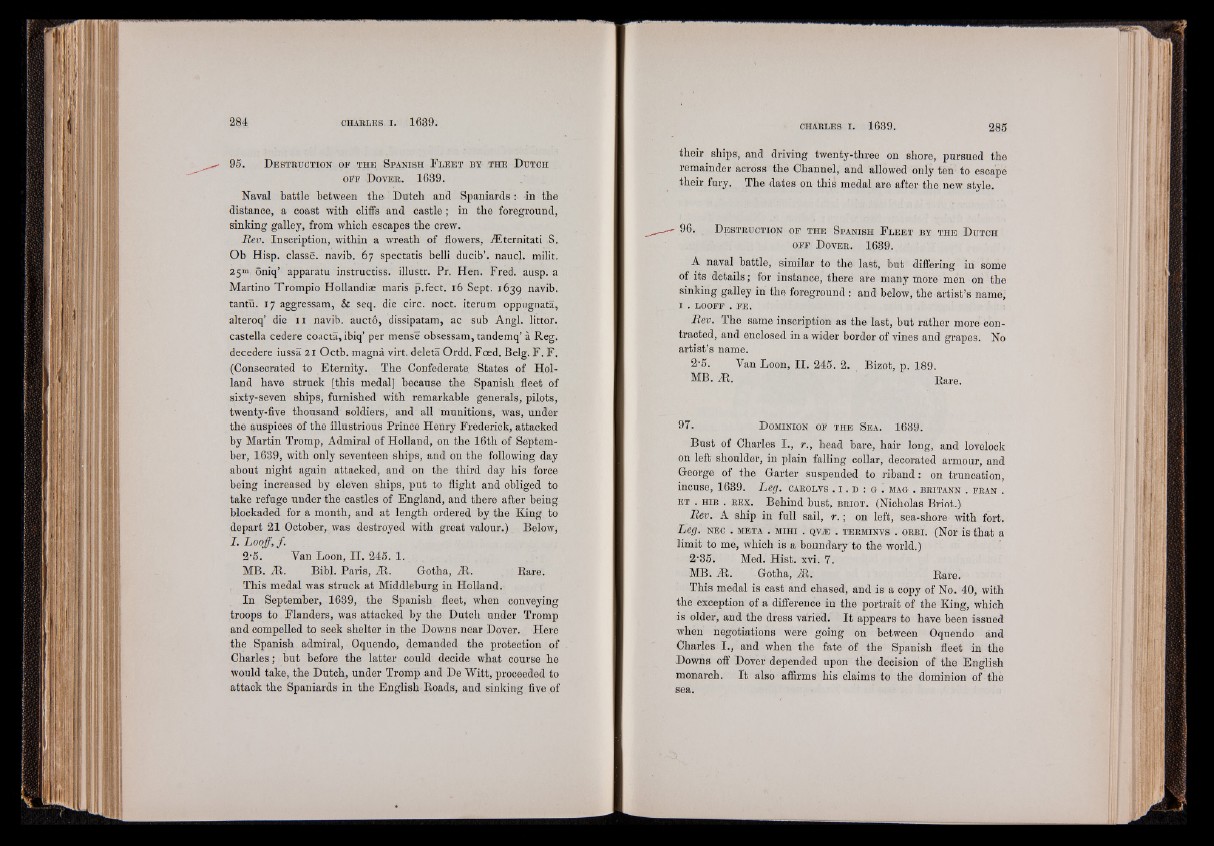
9 5 . D e s t r u c t io n o p t h e S pa n is h F l e e t by t h e D u tc h
oPf D o v e r . 1 6 3 9 .
Naval battle between the Dutch and Spaniards: in the
distance, a coast with cliffs and castle; in the foreground,
sinking galley, from which escapes the crew.
Rev. Inscription, within a wreath of flowers, jFternitati S.
Ob Hisp. classe. navib. 67 spectatis belli ducib’. naucl. milit.
25“ oniq’ apparatu instructiss. illustr. Pr. Hen. Fred. ausp. a
Martino Trompio Hollandiae maris p.feet. 16 Sept. 1639 navib.
tantu. 17 aggressam, & seq. die circ. noct. iterum oppugnata,
alteroq’ die 1 1 navib. aucto, dissipatam, ac sub Angl. littor.
castella cedere coacta, ibiq’ per mense obsessam, tandemq’ a Reg.
decedere iussa 21 Octb. magna virt. deleta Ordd. Feed. Belg. F. F.
(Consecrated to Eternity. The Confederate. States of Holland
have struck [this medal] because the Spanish fleet of
sixty-seven ships, furnished with remarkable generals, pilots,
twenty-five thousand soldiers, and all munitions, was, under
the auspices of the illustrious Prince Henry Frederick, attacked
by Martin Tromp, Admiral of Holland, on the 16th of September,
1639, with only seventeen ships, and on the following day
about night again attacked, and on the third day his force
being increased by eleven ships, put to flight and obliged to
take refuge under the castles of England, and there after being
blockaded for a month, and at length ordered by the King to
depart 21 October, was destroyed with great valour.) Below,
I.LooffJ.
2-5. Van Loon, i t 245. 1.
MB. iR. Bibl. Paris, iR. Gotha, JR. Bare.
This medal was struck at Middleburg in Holland.
In September, 1639, the Spanish fleet, when conveying
troops to Flanders, was attacked by the Dutch under Tromp
and compelled to seek shelter in the Downs near Dover. Here
the Spanish admiral, Oquendo, demanded the protection of
Charles; but before the latter could decide what course he
would take, the Dutch, under Tromp and De Witt, proceeded to
attack the Spaniards in the English Roads, and sinking five of
their ships, and driving twenty-three on shore, pursued the
remainder across the Channel, and allowed only ten to escape
their fury. The dates on this medal are after the new style.
96. D e s t r u c t i o n o p t h e S p a n i s h F l e e t b y t h e D u t c h
o f f D o v e r . 1639.
A naval battle, similar to the last, but differing in some
of its details; for instance, there are many more men on the
sinking galley in the foreground : and below, the artist’s name]
1 . l o o f f . FE.
Rev. The same inscription as the last, but rather more contracted,
and enclosed in a wider border of vines and grapes. No
artist’s name.
2-5. Van Loon, II. 245. 2. Bizot, p. 189.
MB. iR. Rare.
97. D om in io n o f t h e S e a . 1639.
Bust of Charles I., r., head bare, hair long, and lovelock
on left shoulder, in plain falling collar, decorated armour, and
George of the Garter suspended to riband : on truncation,
incuse, 1639. Leg. c a r o l v s . 1 . d : g . m ag . b r i t a n n . f r a n .
e t . h i b . r e x . Behind bust, b r i o t . (Nicholas Briot.)
Rev. A ship in full sail, r. ; on left, sea-shore with fort.
Leg. n e c . m e t a . m ih i . qv^e . t e rm i n v s . o r b i . (Nor is that a
limit to me, which is a boundary to the world.)
2'35. Med. Hist. xvi. 7.
MB. jit. Gotha, iR. Rare.
This medal is cast and chased, and is a copy of No. 40, with
the exception of a difference in the portrait of the King, which
is older, and the dress varied. I t appears to have been issued
when negotiations were going on between Oquendo and
Charles I., and when the fate of the Spanish fleet in the
Downs off Dover depended upon the decision of the English
monarch. It also affirms his claims to the dominion of thè
sea.